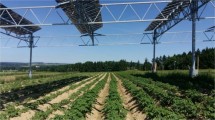Abstract
Agrivoltaic system (AVS) is a conceptual and innovative approach to combining agricultural production with renewable energy. During profound disruption and instability to the energy sectors globally caused by pandemic Covid-19, renewables, especially solar power, are forecast to continue to grow when the world starts to recover from this pandemic. Concurrently, food security issues have become worse and will continue to escalate due to a significant agricultural land decrease. Thus, this conceptual paper describes the core issues of challenges and opportunities for effective dissemination of dual land-use systems (AVS) as an innovative approach and a win-win solution for both productions. The definition and classification of AVS technology, the specification and modification of PV structure for AVS system, and agricultural experts’ concern are discussed in this paper as a suggestion for refinement of AVS technology to increase the rate of adoption by players in the industry. Building renewable energy and agriculture sustainable solutions would ultimately increase global land-use efficiency, minimize agriculture destruction, and reduce greenhouse gas emissions from fossil fuels. Informed and organized efforts to disseminate further this innovation strategy are required if increasing demands for renewables and food security are to be met simultaneously.
Access this chapter
Tax calculation will be finalised at checkout
Purchases are for personal use only
Similar content being viewed by others
References
Dupraz, C., Marrou, H., Talbot, G., Dufour, L., Nogier, A., Ferard, Y.: Combining solar photovoltaic panels and food crops for optimising land use: towards new agrivoltaic schemes. Renew. Energy 36(10), 2725–2732 (2011). https://doi.org/10.1016/j.renene.2011.03.005
The International Energy Agency. World Energy Outlook 2020, Paris (2019). https://www.iea.org/reports/world-energy-outlook-2019
FAO. World Agriculture: Towards 2015/2030 Summary report, Rome (2002). http://www.fao.org/3/y3557e/y3557e00.htm#TopOfPage
Schindele, S., et al.: Implementation of agrophotovoltaics: techno-economic analysis of the price-performance ratio and its policy implications. Appl. Energy 265(October 2019), 114737 (2020). https://doi.org/10.1016/j.apenergy.2020.114737
FAO. Crop Prospects and Food Situation-Quarterly Global Report No 4, Rome (2020). https://doi.org/10.4060/cb2334en
UN. The Sustainable Development Goals Report 2020, New York (2020). https://doi.org/10.29171/azu_acku_pamphlet_k3240_s878_2016
Santra, P., Pande, P.C., Kumar, S., Mishra, D., Singh, R.K.: Agri-voltaics or solar farming: the concept of integrating solar PV based electricity generation and crop production in a single land use system. Int. J. Renew. Energy Res. 7(2), 694–699 (2017)
Metsolar. What is agrivoltaics? How can solar energy and agriculture work together? (2018). https://metsolar.eu/blog/what-is-agrivoltaics-how-can-solar-energy-and-agriculture-work-together/, Accessed 01 Oct 2020
Othman, N.F., Ya’Acob, M.E., Abdul-Rahim, A.S., Hizam, H., Farid, M.M., Abd Aziz, S.: Inculcating herbal plots as effective cooling mechanism in urban planning. Acta Hortic. 1152, 235–242 (2017). https://doi.org/10.17660/ActaHortic.2017.1152.32
Patel, B., Gami, B., Baria, V., Patel, A., Patel, P.: Co-generation of solar electricity and agriculture produce by photovoltaic and photosynthesis-dual model by Abellon, India. J. Sol. Energy Eng. 141(3) (2019). https://doi.org/10.1115/1.4041899
Macknick, J., Beatty, B., Hill, G.: Overview of opportunities for co-location of solar energy technologies and vegetation. Sol. Energy Sites Considerations Areas Veg. Contam. Disturb. Lands (December), 1–21 (2013)
Thompson, E.P., et al.: Tinted semi-transparent solar panels allow concurrent production of crops and electricity on the same cropland. Adv. Energy Mater. 10(35) (2020). https://doi.org/10.1002/aenm.202001189
Cossu, M., et al.: Assessment and comparison of the solar radiation distribution inside the main commercial photovoltaic greenhouse types in Europe. Renew. Sustain. Energy Rev. 94(June), 822–834 (2018). https://doi.org/10.1016/j.rser.2018.06.001
Amaducci, S., Yin, X., Colauzzi, M.: Agrivoltaic systems to optimise land use for electric energy production. Appl. Energy 220(March), 545–561 (2018). https://doi.org/10.1016/j.apenergy.2018.03.081
Pascaris, A.S., Schelly, C., Pearce, J.M.: A First Investigation of agriculture sector perspectives on the opportunities and barriers for agrivoltaics. Agronomy 10(12), 1885 (2020). https://doi.org/10.3390/agronomy10121885
Author information
Authors and Affiliations
Corresponding author
Editor information
Editors and Affiliations
Rights and permissions
Copyright information
© 2022 The Author(s), under exclusive license to Springer Nature Singapore Pte Ltd.
About this paper
Cite this paper
Abidin, M.A.Z., Mahyuddin, M.N., Zainuri, M.A.A.M. (2022). Agrivoltaic Systems: An Innovative Approach to Combine Agricultural Production and Solar Photovoltaic System. In: Mahyuddin, N.M., Mat Noor, N.R., Mat Sakim, H.A. (eds) Proceedings of the 11th International Conference on Robotics, Vision, Signal Processing and Power Applications. Lecture Notes in Electrical Engineering, vol 829. Springer, Singapore. https://doi.org/10.1007/978-981-16-8129-5_119
Download citation
DOI: https://doi.org/10.1007/978-981-16-8129-5_119
Published:
Publisher Name: Springer, Singapore
Print ISBN: 978-981-16-8128-8
Online ISBN: 978-981-16-8129-5
eBook Packages: Intelligent Technologies and RoboticsIntelligent Technologies and Robotics (R0)




